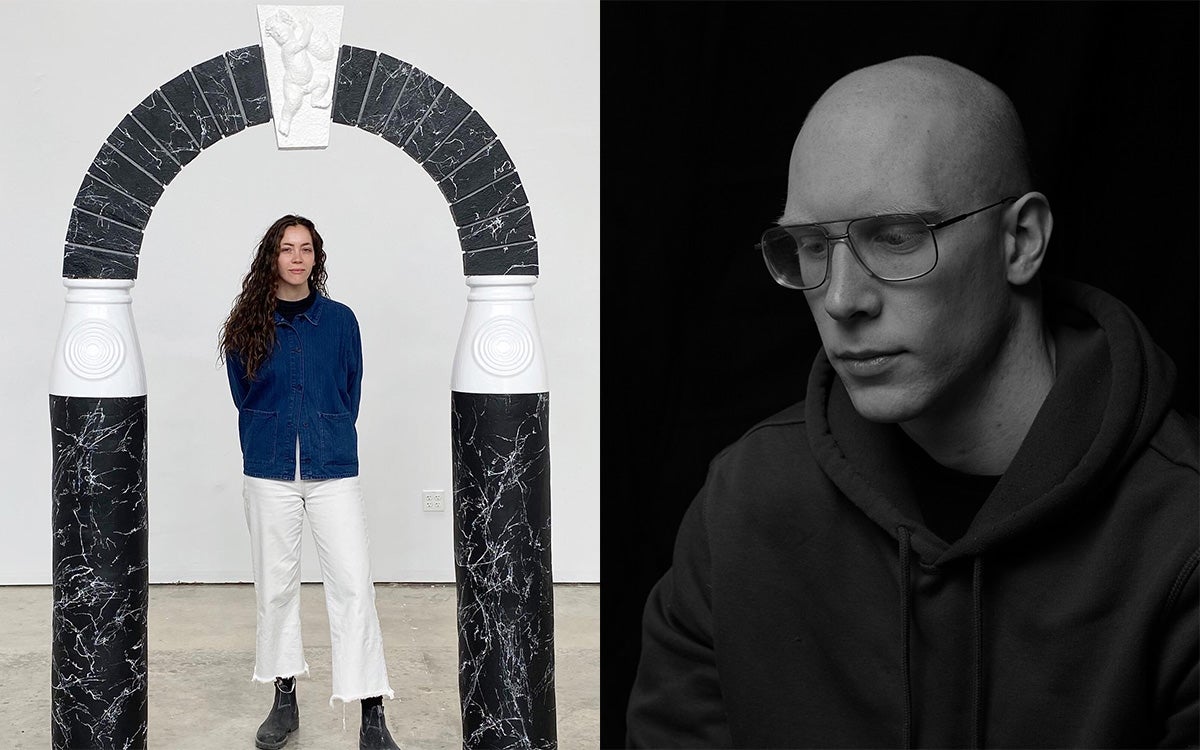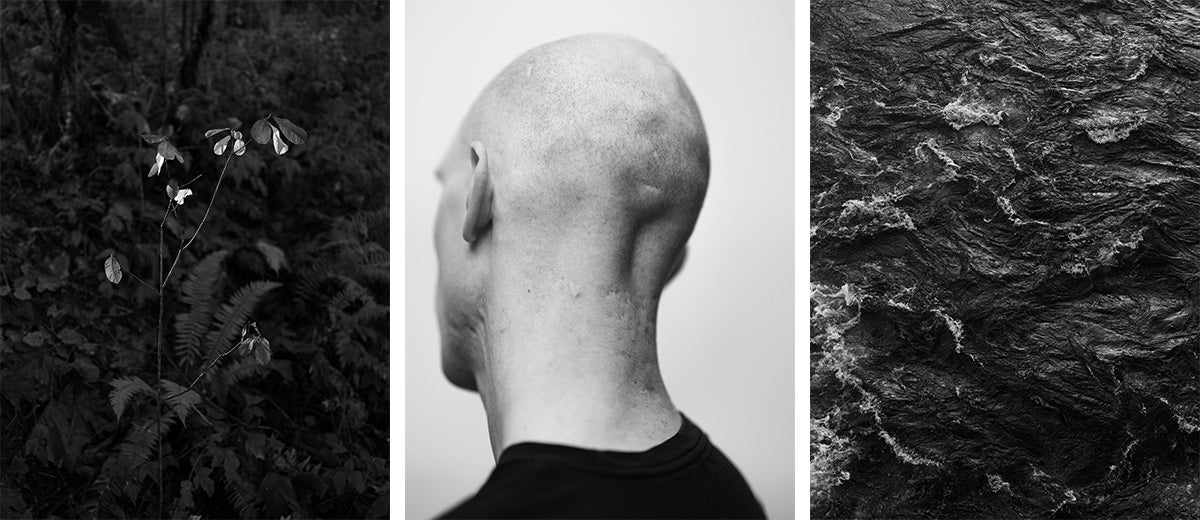 Caroline Turner with her Baroque arch and a self-portrait of Ian Molloy
Caroline Turner with her Baroque arch and a self-portrait of Ian Molloy
Leading up to their MFA show this month at Disjecta Contemporary Art Center, artists Caroline Turner and Ian Molloy are busy expressing big ideas on paper and in video, sculpture, and sound.
Turner is interrogating the present and the future through the transformative properties of an ancient form, the arch.
Molloy is documenting the process of remembering and forgetting through photography and sound.
With Turner and Molloy slated to graduate in June, these efforts are at the heart of completing their MFA projects. And this year, the Department of Art named them Georgianne Teller Singer Dean’s Graduate Fellows in Art, which comes with a $5,000 award to help with completing a master’s project.
The fellowship was established in 2005 by Kenneth M. Singer, MD, to honor his late wife, the nurse and epidemiologist Georgianne Teller Singer, BS Health Sciences ’73, who was a painter and had a lifelong passion for the arts. Singer and his current wife Kendra Singer, BS in Biology ’74, have been honored with the UO Pioneer Award for their generous support across the UO.
“This fellowship will allow me to continue producing my thesis and fully realize the project by providing funding for research materials, production materials, and necessary interventions and guidance,” wrote Molloy.
“I was totally surprised,” Turner said of finding out about the fellowship. “I had been in the woodshop for seven hours when I checked my email, and I was totally floored.”
Their work will be on view beginning May 15 at Disjecta Contemporary Art Center in Portland for the UO Art MFA Thesis Exhibition. Learn more about their thesis projects below.
Hinterland
 A video still from 'Hinterland'
A video still from 'Hinterland'
Caroline Turner is using arches— from a Neolithic dolmen and an ornate Baroque entrance to a crystalline portal—to investigate what society is on the cusp of.
“We’re at this extremely charged moment, and we’re on the cusp of something,” Turner said. “That something is either collapse or acceleration.”
The MFA project, “Hinterland,” draws on both Turner’s sculptural and digital practice, but it began with a written exercise, “Alphabet Retreat,” a fictional depiction of a corporate wellness retreat in the Mojave Desert.
“On the perimeter of the yurts, there are 24 stylistically varying archways; each structure representing both a letter in the Ancient Greek alphabet and a unique point in human history and development,” Turner writes. “The last arch in the circle, the Omega, is barely visible. You can only see it from certain angles; it appears to be almost completely transparent, reflecting a subtle iridescent sheen like an oil slick. When you go to touch it, however, it’s completely solid; impenetrable.”
Turner built one of these arches—a nine-foot-tall Baroque arch with a cherub keystone. From afar, the arch appears to be built from marble, however, Turner said she constructed it out of foam to reinforce the object’s artifice. At Disjecta, a bench will accompany the arch, through which a video installation of the aforementioned trio—a Neolithic dolmen, an ornate Baroque entrance, and a crystalline portal—will appear on a four-foot-long curved screen.
In her proposal for the Singer fellowship, Turner identified that the award would be helpful to foster collaboration for the video with her partner Ian Anderson, a 3D modeling and virtual reality artist. The video result is dreamy and timeless and urgent, feeling akin to a shot from 2001: A Space Odyssey.
“It’s very much an interrogation of the present by looking into the deep past and far future.” Turner said. “They are portals and gateways and ask you to imagine that historical context. The video will aid in the imaginative process.”
Latent Interiors
 'Latent Interiors' images by Molloy which will be on display for the MFA show
'Latent Interiors' images by Molloy which will be on display for the MFA show
For his MFA project “Latent Interiors,” Ian Molloy is using photography and sound to renegotiate and reconcile the personal traumas and mental illness of his life. He came to Eugene from Syracuse, New York, not only to pursue an MFA, but to remember and forget, and to heal.
“The whole thing is about me coming here and finally having access to resources to understand and act on the sort of shortcomings of mental health,” Molloy said. “I’m trying to document and articulate that journey as best as I can.”
Molloy read A Primer for Forgetting: Getting Past the Past at the beginning of graduate school and the book helped him find his footing, both in his mental health treatment and in his thesis.
Molloy, who lives with bipolar disorder, is exploring the perceived dichotomies of the human experience, such as the separation of mind and body, and the relationship between memory and forgetting.
“Digging up and forgetting is part of the healing process. They are not two sides of a binary but two parts of the same thing,” Turner said.
His project will feature nine photos on display at Disjecta, taken with both an iPhone 4 and a digital medium format camera.
“I see the photos operating in two different ways: As documentation—I carry my camera around everywhere. They make sense later. I don’t always understand what they mean in the moment,” Molloy said. “Then there are also photographs I make that are much slower, more methodical, and less rooted in documentation or truth. They are more illustration or sculpture.”
These images will be accompanied by different sonic experiences: recordings of the intercom in the hospital where he stayed in Oregon, and his breath while running, combined with synthesized instrumentation.
“The visual and sonic representation is me negotiating the varieties of experiences with mental illness and treatments,” Molloy said.
